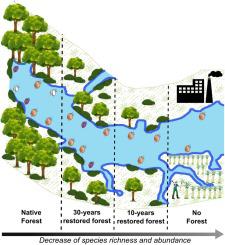当前位置:
X-MOL 学术
›
Limnologica
›
论文详情
Our official English website, www.x-mol.net, welcomes your feedback! (Note: you will need to create a separate account there.)
Response of cladoceran assemblages to restoration of riparian vegetation: a case study in a tropical reservoir of Brazil
Limnologica ( IF 1.7 ) Pub Date : 2020-11-01 , DOI: 10.1016/j.limno.2020.125822 Edissa Emi Cortez-Silva , Gleice de Souza Santos , Mariângela Garcia Praça Leite , Eneida M. Eskinazi-Sant’Anna
Limnologica ( IF 1.7 ) Pub Date : 2020-11-01 , DOI: 10.1016/j.limno.2020.125822 Edissa Emi Cortez-Silva , Gleice de Souza Santos , Mariângela Garcia Praça Leite , Eneida M. Eskinazi-Sant’Anna

|
Abstract In recent decades, riparian vegetation has been removed from important ecosystems around the world, in spite of its high ecological importance for aquatic biota. Nevertheless, the effects of catchment land use on zooplankton have been little studied. The present study investigated if replanting riparian vegetation in a tropical reservoir influences the richness and abundance of cladoceran communities, by addressing the question of whether cladocerans show differences in richness and abundance among four levels of riparian vegetation conditions: 1) native forest (NF); 2) 30 years after forest replanting (R1); 3) 10 years after forest replanting (R2); and 4) no forest (No-F). Zooplankton samples were obtained from 9 stations in the Volta Grande Reservoir, Minas Gerais, Brazil. Cladocerans in zones NF and R1 showed higher levels of richness and abundance than in zones No-F and R2. Ceriodaphnia reticulata, Ceriodaphnia laticaudata, and Diaphanosoma spinulosum showed higher abundances in zones NF and R1. Cladoceran community structure was influenced by the different levels of riparian vegetation. This study showed that the presence and age of riparian forest positively influence the abundance, richness and diversity of cladoceran assemblages. Furthermore, our results indicated that C. reticulata, C. laticaudata and D. spinulosum are more efficient than other cladocerans in exploiting allochthonous resources provided by riparian forest. Functional diversity was higher in zones NF and R1, suggesting that the trait composition of cladoceran assemblages responds positively to recovery of riparian forest. Overall, our research suggests that cladocerans are good indicators of riparian vegetation conditions and that restoration of riparian forest positively affects cladoceran assemblages of tropical reservoirs.
中文翻译:

枝角类群落对河岸植被恢复的响应:巴西热带水库的案例研究
摘要 近几十年来,尽管河岸植被对水生生物群具有很高的生态重要性,但它已从世界各地的重要生态系统中消失。然而,流域土地利用对浮游动物的影响鲜有研究。本研究调查了在热带水库中重新种植河岸植被是否会影响枝角类群落的丰富度和丰度,通过解决枝角类动物是否在四个水平的河岸植被条件之间显示丰富度和丰度差异的问题:1)原始森林(NF);2) 森林补种后 30 年 (R1);3) 森林补种后 10 年(R2);4)没有森林(No-F)。浮游动物样本来自巴西米纳斯吉拉斯州 Volta Grande 水库的 9 个站点。NF 和 R1 区的枝角类动物的丰富度和丰度高于 No-F 和 R2 区。Ceriodaphnia reticulata、Ceriodaphnia laticaudata 和 Diaphanosoma spinulosum 在 NF 和 R1 区显示出更高的丰度。枝角类群落结构受不同水平的河岸植被影响。这项研究表明,河岸森林的存在和年龄对枝角类动物组合的丰度、丰富度和多样性产生积极影响。此外,我们的结果表明,C. reticulata、C. laticaudata 和 D. spinulosum 在开发河岸森林提供的外来资源方面比其他枝角类动物更有效。NF 和 R1 区的功能多样性较高,表明枝角类动物组合的性状组成对河岸森林的恢复有积极的响应。全面的,
更新日期:2020-11-01
中文翻译:

枝角类群落对河岸植被恢复的响应:巴西热带水库的案例研究
摘要 近几十年来,尽管河岸植被对水生生物群具有很高的生态重要性,但它已从世界各地的重要生态系统中消失。然而,流域土地利用对浮游动物的影响鲜有研究。本研究调查了在热带水库中重新种植河岸植被是否会影响枝角类群落的丰富度和丰度,通过解决枝角类动物是否在四个水平的河岸植被条件之间显示丰富度和丰度差异的问题:1)原始森林(NF);2) 森林补种后 30 年 (R1);3) 森林补种后 10 年(R2);4)没有森林(No-F)。浮游动物样本来自巴西米纳斯吉拉斯州 Volta Grande 水库的 9 个站点。NF 和 R1 区的枝角类动物的丰富度和丰度高于 No-F 和 R2 区。Ceriodaphnia reticulata、Ceriodaphnia laticaudata 和 Diaphanosoma spinulosum 在 NF 和 R1 区显示出更高的丰度。枝角类群落结构受不同水平的河岸植被影响。这项研究表明,河岸森林的存在和年龄对枝角类动物组合的丰度、丰富度和多样性产生积极影响。此外,我们的结果表明,C. reticulata、C. laticaudata 和 D. spinulosum 在开发河岸森林提供的外来资源方面比其他枝角类动物更有效。NF 和 R1 区的功能多样性较高,表明枝角类动物组合的性状组成对河岸森林的恢复有积极的响应。全面的,


























 京公网安备 11010802027423号
京公网安备 11010802027423号